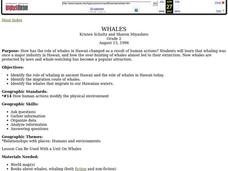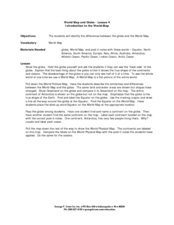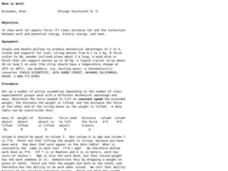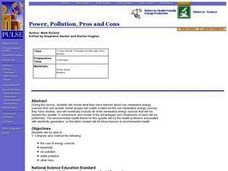Curated OER
State of Matter - Atoms
Learners examine and discuss how atoms change from solid to liquid to gas. They inflate a balloon by melting ice that converts to steam, and discuss the results.
Curated OER
Be a Geography Observor and Recorder
Young scholars investigate the human and physical features of their school neighborhood. They observe the physical and man made features outside, make illustrations of their observations, and develop a class list of their observations.
Curated OER
Locating Vent Fields Using CTD Data
Students describe the way hydrothermal vents work. Students work on locating vent regions through remote collection of data about water temperature and density. Comparing density and temperatures graphs, students search for indicators...
Curated OER
Matter
In this matter worksheet, students are given 10 sentences with italicized terms that are wrong. Students correct the terms to appropriately fit the sentences. Topics are related to matter such as physical and chemical properties, solids,...
Curated OER
How Much Carbon is Held by the World's Forests?
Seventh graders identify how much carbon is held by the world's forests. For this forestry lesson, 7th graders study the carbon cycle and discuss what role humans have had on climate change. Students write a one page paper on how the...
Curated OER
Building And Launching a Model Rocket
Students are introduced to the basic parts of rockets and the physical forces at work in the flight of rockets. They build and launch a model rocket and discuss the challenges of launching a real rocket.
Curated OER
Methods of Heat Transfer
Eighth graders discuss the forms of heat transfer that relate to the human body. Discussion revolves around the ability of different designs of hats to change the rate of heat transfer to and from the body. Students then experiment...
Curated OER
Whales
Second graders identify the role of whaling in ancient Hawaii and the role of whales in Hawaii today, identify the migration route of whales and identify the whales that migrate to our Hawaiian waters.
Curated OER
The Landscape
Learners create works of art that portray their connection to their environment, construct class sculptural landscape, record changes to their environment since their grandparents' time, and paint one referenced art work from new...
Curated OER
Erosion and Deposition
Fifth graders study the processes of erosion, transportation, and deposition in soil. They walk outside the school to see examples and then accurately create a physical model which shows each type of soil movement and allows them to...
Curated OER
Science: Draining the Land - the Mississippi River
Students use topographic maps to identify parts of rivers. In addition, they discover gradient and predict changes in the channels caused by variations in water flow. Other activities include sketching a river model with a new channel...
Curated OER
Resistor-Capacitor Circuits
In this physics worksheet, students determine whether the current flows through the resistor after the switch is closed and explain why. Then they determine whether the capacitor will discharge faster or slower if there is an increase in...
Curated OER
Chapter 3 and 4 Review
In this physics review worksheet, students complete 42 matching, fill in blank, and problem solving questions pertaining to Newton's laws, force formulas, distance formulas, and simple machines.
Curated OER
Animals: Worms
Students research the physical characteristics of mealworms and tubefex. In this worm lesson, students explore worms using a microscope. Students search their environment for worms.
Curated OER
Factors Affecting Plant Growth
Students determine the physical and chemical factors that affect plant growth. In this biology lesson, students explain the role of hormones in plants. They investigate how competition with other plants affect their growth.
Curated OER
NickNews: Winners and Losers
Students view the excerpt from NickNews entitled, "Winners and Losers." In groups, they categorize a variety of words and images relating to weight, healthy eating, and healthy lifestyle. They discuss adopting positive eating habits,...
Curated OER
Solids, Liquids, and Gases
First graders explore the properties of matter. In this states of matter lesson, 1st graders conduct scientific investigations that require them to mix, cool, and heat objects in order to observe changes in the properties of matter.
Curated OER
Introduction to the World Globe
Students examine a globe and the world map to see what constitutes the differences. For this world map introductory lesson, students discuss what they see when they view the globe. Students then, look at a world map and compare the...
Curated OER
Energize Your Future
Students consider the positive and negative aspects of alternative energy. In this physical science lesson plan, students consider the sources of energy they use everyday. Students compare alternative sources of energy and complete a...
Curated OER
What is Work?
Pupils investigate the connection between work, potential energy, kinetic energy, and heat. In this physics lesson, students use pulleys to produce mechanical advantages and incline planes to demonstrate energy conversion.
Curated OER
Elements of Chemistry: Solids, Liquids and Gases
Young scholars predict if icebergs melting has an effect on the sea level rising. In this global warming lesson students complete an experiment to see the effects of melting icebergs and write a conclusion on their data collected.
Curated OER
Power, Pollution, Pros and Cons
Students review what they know about non-renewable energy, compare and contrast advantages and drawbacks of each type, such as cost of energy sources, feasibility, air pollution, water pollution, and other risks, and create table listing...
Curated OER
The Same But Different
Third graders observe a frozen container filled with ice and discuss what happens when the ice sits out in the room. They practice measuring the mass and volume of the ice, watch as the frozen container is placed in a warm water bath to...
Curated OER
Exploring the Sun's Role in Living Systems
Learners create graphic organizer webs that illustrate their thinking about seasonal physical and biological changes caused by changes in sunlight. They identify the central role of sunlight in living systems.

























